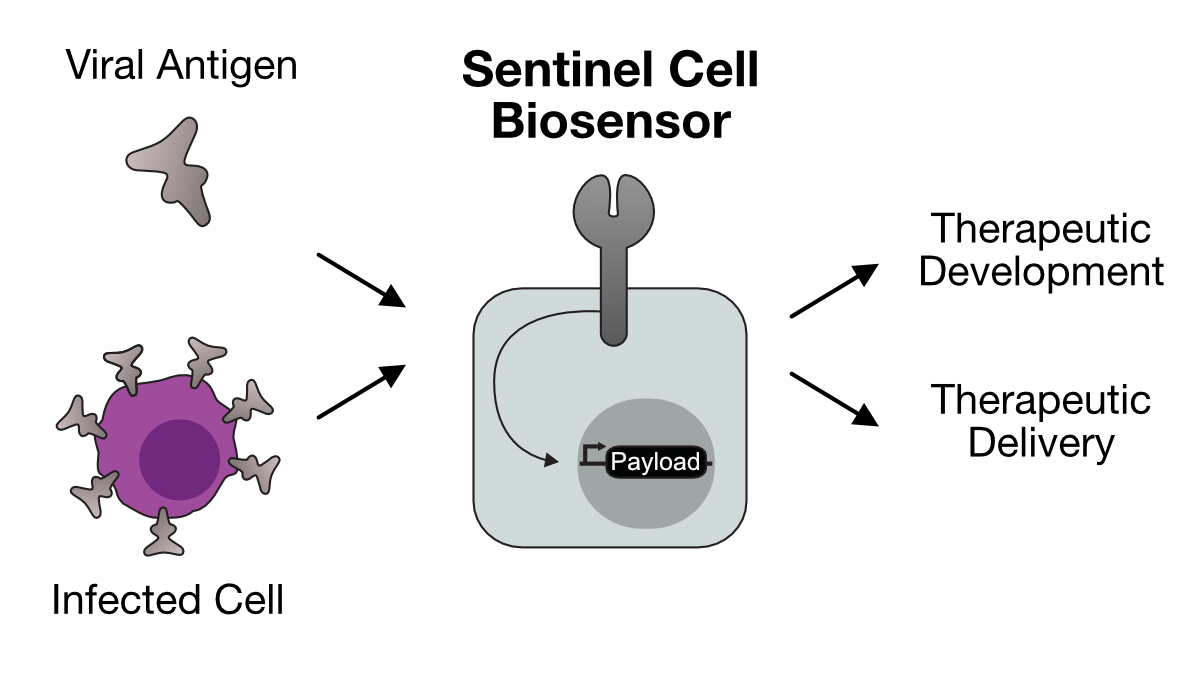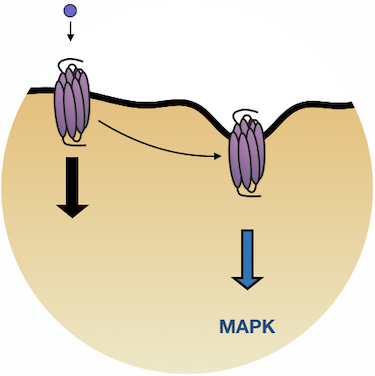About Me
Cell biologist studying how cells perceive their environments and respond with discrete behaviors. Interests include pharmacology, automated quantitative image analysis, teaching, and mentoring.
Research
Our cells have have a limited number of tools to sense their environment, but they have to be capable of responding to a practically unlimited number of environmental signals. I study how cells decode different signals acting on the same machinery to produce distinct behaviors. Currently, I use the convergent signaling molecule cyclic AMP to study this, but in the past I have also used G protein-coupled receptors.
Sentinel cells for genetic encoded responses to pathogens
 Current therapies targeting viral and microbial pathogens rely on systemically administered treatments
with profound potential for off-target effects. With our 'sentinel cells', we propose a model that has shown
considerable target in treating blood cancers, where engineered cells can sense and respond to pathogenic
threats locally and intelligently. Using SARS-CoV-2 as a model pathogen, we demonstrate that sentinel cells can
detect infected cells, and respond with customized genetic programs. These sentinel cells have potential as both
antipathogen therapies as well as in novel drug and therapeutic development.
Current therapies targeting viral and microbial pathogens rely on systemically administered treatments
with profound potential for off-target effects. With our 'sentinel cells', we propose a model that has shown
considerable target in treating blood cancers, where engineered cells can sense and respond to pathogenic
threats locally and intelligently. Using SARS-CoV-2 as a model pathogen, we demonstrate that sentinel cells can
detect infected cells, and respond with customized genetic programs. These sentinel cells have potential as both
antipathogen therapies as well as in novel drug and therapeutic development.
Endocytic dwell time of the µ opioid receptor regulates signaling in a ligand depdenent manner
 The µ opiod receptor (µOR) is the target of drugs like morphine and heroin. But it is also the target of
chemicals our bodies produce called endorphins. It is poorly understood why morphine is so addictive,
but endorphins are not. One difference between how these drugs act on µOR is that morphine causes the receptor
to be taken up into the cell very quickly after it interacts with the drug. I discovered that the slower this uptake
occurs, the more signaling is produced from the MAPK signaling pathway. This signaling difference might
contribute to the ways in which endogenous opioids have different effects comapred to exogenous ones.
The µ opiod receptor (µOR) is the target of drugs like morphine and heroin. But it is also the target of
chemicals our bodies produce called endorphins. It is poorly understood why morphine is so addictive,
but endorphins are not. One difference between how these drugs act on µOR is that morphine causes the receptor
to be taken up into the cell very quickly after it interacts with the drug. I discovered that the slower this uptake
occurs, the more signaling is produced from the MAPK signaling pathway. This signaling difference might
contribute to the ways in which endogenous opioids have different effects comapred to exogenous ones.
Education
Research & Work Experiences
- Synthetic biology approaches to sensing and manipulating cell signaling
- Developed technique for measuring GPCR exocytosis using live cell microscopy, and automated image analysis with machine learning deployed in MATLAB and Python.
- Collected live cell imaging data for 2 collaborators, and trained a collaborator to perform microscopy experiments
- Significant mentorship of 5 PhD, 1 Masters, and 3 Undergraduate students
- Demonstrated that opioid receptors signal from endocytic domains after activation using total internal fluorescence microscopy, fluorescent biosensors, automated image analysis in ImageJ and MATLAB, and immunoblotting
- Discovered distinct protein mediators of adrenergic receptor endocytosis and signaling
- Tech support generalist – Hardware, Networking, macOS, Windows, and Linux
- Provided excellent customer service as recognized by peer bonus system 40 times
- Operations rotation with corporate infrastructure SRE – automated server provisioning, maintenance, and monitoring using shell scripting, Python, and Ganeti
- Communicated technical issues throughout the support organization through drafting and editing of regular newsletter and technical explainers
